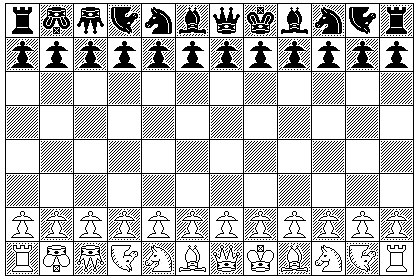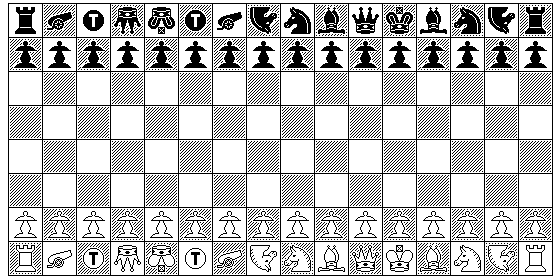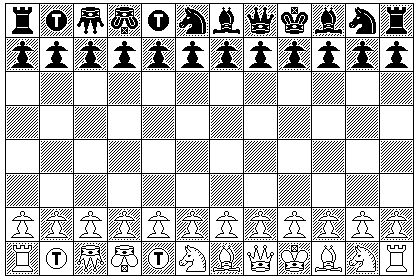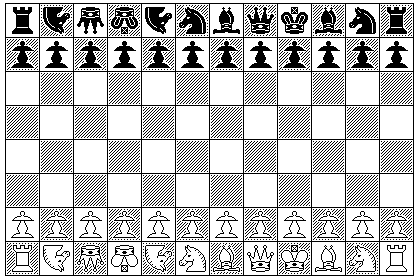
In thinking about how Random Variant Chess could be improved, providing more possibilities of variation on the one hand, and better preserving the effectiveness of Castling from ordinary Chess, I came up with this version of enlarged Chess to serve as a basis:

While still avoiding the messy nature of the random array used in variants like Chess 960, instead of having the almost complete left-to-right symmetry of normal Chess, if I am widening the board, why not consider having the King and Queen shifted closer to the Kingside, so that at least Kingside Castling is no worse than Queenside castling in conventional chess, even though the board is 12 squares wide instead of 10?
Here, the initial array is:
Rook, Man, Princess, Camel, Knight, Bishop, Queen, King, Bishop, Knight, Camel, Rook
Thus, both the Man and one Princess are added, as well as a pair of Camels, thus adding the pieces I think would add the most interest to an enlarged version of Chess; avoiding the Empress as perhaps too powerful. Thus, only one major piece, a Princess (Knight plus Bishop), is added; the Man, an ordinary piece that moves one square in any direction like the King is a minor piece, and the Camel, moving like a Knight, but with a longer jump that confines it to squares of one color is less than a minor piece - so the game, despite being enlarged, remains more balanced.
This inspired me, however, to examine the available possibilities even further.

The board could be further expanded, as shown above, for example.
This layout suggests that the Man might be replaced by a piece such as the Adventitious King or Crown Prince in some forms of Great Chess.
But a piece that becomes a second King after the first King is captured only prolongs the game, rather than really adding something to it.
What could be done so as to instead add an important strategic choice to the game? After some thought, I came up with the following idea:
Let us treat the layout as:
Rook, Cannon, Tiger, Princess, Vizier, Tiger, Cannon, Camel, Knight, Bishop, Queen, King, Bishop, Knight, Camel, Rook
where:
Only the King can Castle, and Castling remains a two-square move of the King.
Victory is obtained by checkmating the King. (Dynamic Scoring, of course, may be applied.)
The Vizier has the same move as the King, except for Castling. It may be captured during the game, and moved en prise, like any ordinary piece. However, unlike a Man, it does have one important special property: if a player's Vizier has been captured, he can not promote a Pawn to a piece which includes the Rook's move.
In the variant shown, this would mean that a Pawn, in that case, could not be promoted to a Rook or a Queen. (It could, however, still be promoted to a Cannon.) If this variant is used as the basis for a form of Random Variant Chess, or even an ordinary variant with a different complement of pieces, it might be noted that this rule also excludes promotion to an Empress (Rook plus Knight). Also, this rule might also be extended to eliminate promotion to a Griffin in that case as well.
|
To avoid an end-run around this rule, it should also be noted that it is never allowed to promote a Pawn to a Vizier, just as it is never allowed to promote a Pawn to a King. |
Now, checkmate remains sufficient for victory, but capturing the Vizier becomes a very important secondary objective as well.
Since the Vizier itself has a short-range move, this would not easily resolve to an exchange of Viziers in the way that ordinary Chess often includes an exchange of Queens. As well, while an exchange of Queens simplifies the situation, making it easier for the player with an advantage to win, because the loss of the Vizier removes the ability to promote Pawns to those pieces which easily render checkmate, an exchange of Viziers is not good compensation for the loss of one's own Vizier if one is the player with an advantage that one is hoping to convert to a win.
Thus, capturing the opponent's Vizier is somewhat analogous to moving one's King to a citadel in some classic versions of Great Chess, but the fact that the Vizier can be attacked and defended, and the fact that the Vizier's capture doesn't absolutely force a draw in general, it just narrows the chances for a win, would seem to encourage the hope that this would add variety and strategic depth to Chess.
Incidentally, the Tiger is a Bishop-mover Knight-capturer; it is significantly less powerful than the Princess, but the fact that it's a long-range piece which can execute a Knight fork might cause one to think it's at least a little more powerful than either of those minor pieces alone. However, each time a Tiger captures, it changes colors; thus, for as long as a player has both Tigers, the first Tiger capture (and subsequent odd-numbered ones) limits the player by now leaving him with two Tigers of the same color - this makes that piece a bit tricky and interesting.
Also throwing in the Cannon from Chinese Chess, admittedly, shows that I'm trying to pile up as many possible sources of interest and variety as I can. But I think that the Vizier is a relatively original contribution on my part, and a significant one.
The player who has obtained a slight lead through careful positional play has to devote resources to protecting his Vizier in order to be able to realize his advantage on the chessboard as points on the scoreboard. But making it more difficult to win in itself is more likely to be a bad thing than a good thing; Dynamic Scoring was invented to deal with that precise issue.
The benefit I see this variant providing is that the choices offered to the players, not just between choosing an attacking opening and a defensive one (experience has shown the latter choice is the clear winner) but between choosing to fully defend one's Vizier as well as one's King, on whether to attack the opponent's Vizier or the opponent's King, are now more likely to contain a non-transitive element. That is, in the desired case, no one choice will always be "best"; instead, every choice will be beaten by some choices by the opponent, and yet there will also be a choice the player can make, or could have made, to beat each of those choices.
Of course, there can still be some choices so bad that they can always be beaten, but they can merely be avoided. This is a very important component in successful game design in general, as it keeps the game interesting.
In a game like Chess, though, with complete information and without a random element, a real non-transitive situation is not possible. Instead, a situation that is nontransitive in practice, because of the apparent randomness introduced by the fact that the game is not fully analyzed, is the goal. Regular Chess is not fully analyzed, which is why there is no one best Chess opening, but the fundamental strategy of defensive play appears to dominate from post-Steinitz experience; what I'm hoping to achieve is that there will be non-transitivity at the level of large-scale strategy, not just in the details of the opening.
However, if this goal is achieved well, the result might be a game which rewards all players who have achieved a certain basic level of competence, due to a large advantage for making the right initial choice of strategy, with a near-equal chance to win. Despite having an increase of complexity with a larger board and more pieces, that would be open to criticism as dumbing down Chess to the level of scissors-paper-stone, also known as rock-paper-scissors, the paradigmatic example of non-transitivity.
I don't think that it's likely that I will achieve the goal of non-transitivity so effectively as to have that result, but it should be noted that, in fact, the goal of most "improved" variants of Chess is to make Chess more accessible, by reducing such things as the need to deeply study opening variations.
Also, it might be noted that it's relatively easy to play this game with standard equipment. Use three normal chess sets, two identical full-sized ones, and one set with smaller pieces. Then, one has two boards to place next to each other, and sixteen pawns. The small Knights can represent the Camels; the small Rooks can represent the Cannons, the small Bishops can represent the Tigers, and the small King can represent the Vizier, and the small Queen can represent the Princess.
And another special rule comes to mind. Usually, capturing the opponent's Vizier tends towards drawing the game. If we leave Castling to the King, we could give the Vizier the option to make one Knight's move during the game. With a rule like that, it would be possible to add the rule that if one captures the opponent's Vizier with one's own Vizier, one wins the game. (Of course, this one is not an original idea on my part; its immediate source is obvious.)
However, a variant on a board with 16 columns might be viewed as large and unwieldy, whereas a board with 12 columns is a more reasonable enlargement of the game. Thus, if the Vizier is a valuable addition to Chess, perhaps it could still be retained in a variant with this layout:

that is,
Rook, Tiger, Princess, Vizier, Tiger, Knight, Bishop, Queen, King, Bishop, Knight, Rook
or one could even replace the Tigers by Camels, to return to the piece complement, if not the layout, of the first variant shown, except for replacing the Man by a Vizier. However, the Tiger seems more appropriate to retaining some vestige of the principle embodied in the layout of Grand Vizier Chess that the left half of the board is potentially a second theatre of conflict.
And this could be used to begin a new version of Random Variant Chess, since several possibilities suggest themselves based on what we've seen here:
1) Tiger, Princess, Vizier, Tiger 2) Cannon, Princess, Vizier, Cannon 3) Camel, Princess, Vizier, Camel 4) Princess, Empress, Vizier, Princess 5) Princess, Griffin, Vizier, Princess 6) Tiger, Cannon, Vizier, Tiger
as a beginning, if we keep all the regular chess pieces, and only vary the four new ones, and without being too ambitious, we can start with a minimal number of variants, selectable by a normal six-sided die.
The Griffin, not yet seen on this page, has a move consisting of one diagonal step, followed by a Rook move of two or more squares; thus, it can be blocked by intervening pieces, but otherwise it can move like a Camel or take any similar but more elongated move.
Of course, that won't be sufficient to create the massive increase in the number of opening arrangements required to prevent the emergence of a body of opening knowledge.
Perhaps one could go a bit further:
1 Camel Cannon/Leo 2 Giraffe Princess/Amazon 3 Zebra Empress 4 Tiger Nightrider 5 Cannon Rhinoceros 6 Princess Griffin
where the pieces are as defined on the page describing Random Variant Chess; this provides 36 variants, still a modest number, but which should be enough to put a dent in memorizing opening variants.
The first roll decides which piece type occurs on b1 and e1, and the second which piece type occurs on c1. If the type indicated for c1 is the same as previously indicated for b1 and e1, the type after the slash is used instead.
Note that the Nightrider, in the initial configuration, would only directly threaten the Pawn at f7; with a piece such as the Nightrider, one must be on the lookout for an absurd result, such as both kings being checkmated in an innocent-looking initial array.
The number of possibilities can be easily increased still further with two coin flips: one for determining if the pieces at b1 and e1 are swapped with the Knights, and then one to determine if the piece at c1 is swapped with the Queen.
Thus, 144 possibilities are attained in a very simple fashion.
The additional possibilities opened up by Modest Vizier Chess and the features of ancient Great Chess variants suggest further changes to the game.
Both the King and the Vizier are allowed to Castle, where Castling is a two-square move of the King followed by the Rook jumping to the next square after the King or Vizier in the same way as in normal Chess.
The Vizier does not have a Knight's move once per game. But it can capture the opposing Vizier in the same fashion that a Cannon captures a piece: along Rook lines, jumping over exactly one piece belonging to either player.
When a player's Vizier is captured, he may no longer promote a Pawn to a Rook, Queen, Empress, Amazon, or Griffin. It is possible to win the game by capturing the opponent's Vizier with one's own Vizier in addition to doing so by checkmating the opponent's King. (Note that the Cannon-style capture, despite being symmetrically available to both players, creates interesting possibilities from this rule. For example, a piece required to block a check by interposition might expose a Vizier to this type of capture.)
The complement of pieces can be decided by two dice rolls as listed above. Then four possibilities are chosen by random selection: whether or not to exchange the Queen with the piece beside the Vizier, such as a Princess or Empress, and also whether or not to exchange the Knights with the paired pieces on the Vizier's side of the board, such as Camels or Tigers.
This gives 144 possible arrays fairly simply, for example with two dice rolls and two coin flips.
In a series of games, that is, a match, this is done for the first two games in every four, with the variants repeating in the pattern 1 2 2 1 as the players alternate colors. In a tournament, it is also done once for all the games played in each round, as well as being done for the first two rounds in every four following the pattern given for matches.
After this takes place, each player decides, and commits to, without the other player knowing, to one of four possible arrangements of his pieces: the array may be placed normally from left to right or reversed, and the King and the Vizier may be swapped or not. This can be done by placing two distinct tokens either side up behind a cover.In the case of a conventional variant, without this random element, the fixed starting array I will suggest is:
Rook, Camel, Princess, Vizier, Camel, Knight, Bishop, Queen, King, Bishop, Knight, Rook

as with the other features of the game, a powerful initial array should not be required. But with two ways to bring the game closer to a draw - capturing the opponent's Vizier, and thus preventing promotion to the pieces best suited to inflicting checkmate, or bringing one's own Vizier to its citadel, and thus giving one's King the move of a Knight, making it harder to checkmate it - perhaps more power, rather than less, is needed to balance the game.
And, finally, the special rule that gives this game its name:
If one moves one's King to the opponent's Queen's Rook square (or King's Rook square if one has either reversed the array or swapped the King and Vizier, but not both), one's Vizier is promoted to a Winged Vizier, and has a Knight's move in addition to its other moves.
Similarly, moving one's Vizier to the opponent's Rook square on the opposite side of the board leads to the King being promoted to a Winged King, with the Knight's move in addition to its other moves.
In this way, driving the King to a corner of the board to checkmate it won't result in giving it the Knight's move to escape with in the case of one of the board's corners, which is why the two pieces promote each other, rather than being themselves promoted when they reach their respective citadel squares.
This change of board state is primarily intended to make it easier to remember that the King has paid a visit to its citadel square, because doing so has another important effect: if a player wins when he has a Winged Vizier on the board, it counts as two games.
With conventional Chess scoring, this is done as follows:
Draw 1/2 1/2 Win 1 0 Double Win 1 1/2 -1/2
so that the sum of both scores always remains 1, and the difference between the two scores is what is doubled.
Thus, a player who is ahead is motivated to take the risky journey of moving his King across the board for a higher score, rather than this being a way to draw. But moving the Vizier across the board is a defensive move, since it gives the King a power to escape more easily from attempted mates.
Moving the King to its citadel moves the game away from a draw; moving the Vizier to its citadel, or capturing the opponent's Vizier with a piece other than one's own Vizier, are ways to turn a potential loss into a draw, but not in the direct or certain way that moving the King to a citadel did in historical Great Chess variants with citadels.
Most importantly, it only limits one's opponent's chance to win instead of draw, so, as this tends to be done by the player with an advantage, it will not end up creating as many draws.
Also, note that making the King into a Winged King doesn't increase one's points for winning; having so much additional ability to escape from mate seems reward enough.
By adding a Knight's move to the Vizier, bringing the King to its citadel not only increases the points for a win, but also makes it harder for the other player to capture the Vizier and thus make it more difficult to win; thus, this is doubly an offensive move although it defends the Vizier.